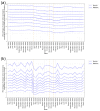The impact of COVID-19 on medication reviews in English primary care. An OpenSAFELY-TPP analysis of 20 million adult electronic health records
- PMID: 38531661
- PMCID: PMC7616229
- DOI: 10.1111/bcp.16030
The impact of COVID-19 on medication reviews in English primary care. An OpenSAFELY-TPP analysis of 20 million adult electronic health records
Abstract
Aims: The COVID-19 pandemic caused significant disruption to routine activity in primary care. Medication reviews are an important primary care activity ensuring safety and appropriateness of prescribing. A disruption could have significant negative implications for patient care. Using routinely collected data, our aim was first to describe codes used to record medication review activity and then to report the impact of COVID-19 on the rates of medication reviews.
Methods: With the approval of NHS England, we conducted a cohort study of 20 million adult patient records in general practice, in-situ using the OpenSAFELY platform. For each month, between April 2019 and March 2022, we report the percentage of patients with a medication review coded monthly and in the previous 12 months with breakdowns by regional, clinical and demographic subgroups and those prescribed high-risk medications.
Results: In April 2019, 32.3% of patients had a medication review coded in the previous 12 months. During the first COVID-19 lockdown, monthly activity decreased (-21.1% April 2020), but the 12-month rate was not substantially impacted (-10.5% March 2021). The rate of structured medication review in the last 12 months reached 2.9% by March 2022, with higher percentages in high-risk groups (care home residents 34.1%, age 90+ years 13.1%, high-risk medications 10.2%). The most used medication review code was Medication review done 314530002 (59.5%).
Conclusions: There was a substantial reduction in the monthly rate of medication reviews during the pandemic but rates recovered by the end of the study period. Structured medication reviews were prioritized for high-risk patients.
Keywords: general practice; prescribing; primary care.
© 2024 The Authors. British Journal of Clinical Pharmacology published by John Wiley & Sons Ltd on behalf of British Pharmacological Society.
Conflict of interest statement
Conflict of interest statement
All authors have completed the ICMJE uniform disclosure form at
Figures




References
-
- Curtis HJ, MacKenna B, Wiedemann M, Fisher L, Croker R, Morton CE, et al. OpenSAFELY NHS Service Restoration Observatory 2: changes in primary care activity across six clinical areas during the COVID-19 pandemic. Br J Gen Pract. 2023;73(730):e318–e331. doi: 10.3399/BJGP.2022.0301. - DOI - PMC - PubMed
-
- Fisher L, Curtis HJ, Croker R, Wiedemann M, Speed V, Wood C, et al. Eleven key measures for monitoring general practice clinical activity during COVID-19 using federated analytics on 48 million adults’ primary care records through OpenSAFELY. medRxiv. doi: 10.7554/eLife.84673. Published online October 31, 2022. - DOI - PMC - PubMed
MeSH terms
Grants and funding
- 2021.0157/Health Data Research UK
- 222097/WT_/Wellcome Trust/United Kingdom
- COV-LT2-0073/NIHR funded CONVALESCENCE programme
- MR/W016729/1/MRC_/Medical Research Council/United Kingdom
- MR/V015737/1/MRC_/Medical Research Council/United Kingdom
- MC_PC_20059/MRC_/Medical Research Council/United Kingdom
- COV-LT-0009/DH_/Department of Health/United Kingdom
- MC_PC_20030/MRC_/Medical Research Council/United Kingdom
- NIHR135559/NIHR funded CONVALESCENCE programme
- 222097/Z/20/Z/WT_/Wellcome Trust/United Kingdom
- COV-LT-0009/NIHR funded CONVALESCENCE programme
- COV-LT2-0073/DH_/Department of Health/United Kingdom
- HDRUK2021.000/Health Data Research UK
- MC_PC_20058/UK Research and Innovation
- MC_PC_20030/UK National Core Studies Programme
- MC_PC_20058/MRC_/Medical Research Council/United Kingdom
LinkOut - more resources
Full Text Sources
Medical
Miscellaneous

